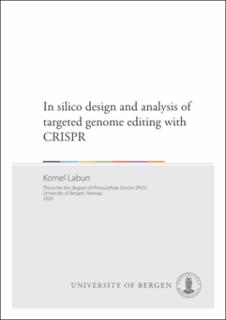| dc.contributor.author | Labun, Kornel | |
| dc.date.accessioned | 2020-02-26T13:18:39Z | |
| dc.date.available | 2020-02-26T13:18:39Z | |
| dc.date.issued | 2020-01-27 | |
| dc.date.submitted | 2020-01-09T19:35:43.791Z | |
| dc.identifier | container/c5/70/88/84/c5708884-6ed1-45fd-bfb6-28e4ef963e7e | |
| dc.identifier.uri | https://hdl.handle.net/1956/21443 | |
| dc.description.abstract | CRISPR/Cas systems have become a tool of choice for targeted genome engineering in recent years. Scientists around the world want to accelerate their research with the use of CRISPR/Cas systems, but are being slowed down by the need to understand the technology and computational steps needed for design and analysis. However, bioinformatics tools for the design and analysis of CRISPR experiments are being created to aid those scientists. For the design of CRISPR targeted genome editing experiments, CHOPCHOP has become one of the most cited and most used tools. After the initial publication of CHOPCHOP, our understanding of the CRISPR system underwent a scientific evolution. I therefore updated CHOPCHOP to accommodate the latest discoveries, such as designs for nickase and isoform targeting, machine learning algorithms for efficiency scoring and repair profile prediction, in addition to many others. On the other spectrum of genome engineering with CRISPR, there is a need for analysis of the data and validation of mutants. For the analysis of the CRISPR targeted genome editing experiments, I have created ampliCan, an R package that with the use of ‘editing aware’ alignment and automated normalization, performs precise estimation of editing efficiencies for thousands of CRISPR experiments. I have benchmarked ampliCan to display its strengths at handling a variety of editing indels, filtering out contaminant reads and performing HDR editing estimates. Both of these tools were developed with the idea that biologists without a deep understanding of CRISPR should be able to use them, and at the same time seasoned experts can adjust the settings for their purposes. I hope that these tools will facilitate adaptation of CRISPR systems for targeted genome editing and indirectly allow for great discoveries in the future. | en_US |
| dc.language.iso | eng | eng |
| dc.publisher | The University of Bergen | en_US |
| dc.relation.haspart | Paper 1: CHOPCHOP v2: a web tool for the next generation of CRISPR genome engineering. K Labun, TG Montague, JA Gagnon, SB Thyme, E Valen, 2016, Nucleic acids research 44 (W1), W272-W276. The article is available in the main thesis. The article is also available at: <a href="https://doi.org/10.1093/nar/gkw398" target="blank">https://doi.org/10.1093/nar/gkw398</a> | en_US |
| dc.relation.haspart | Paper 2: CHOPCHOP v3: expanding the CRISPR web toolbox beyond genome editing. K Labun, TG Montague, M Krause, Y Torres Cleuren, H Tjeldnes, E Valen, 2019, Nucleic Acids Research 47 (W1), W171-W174. The article is available in the main thesis. The article is also available at: <a href="https://doi.org/10.1093/nar/gkz365" target="blank">https://doi.org/10.1093/nar/gkz365</a> | en_US |
| dc.relation.haspart | Paper 3: Accurate analysis of genuine CRISPR editing events with ampliCan. K Labun, X Guo, A Chavez, G Church, JA Gagnon, E Valen, 2019, Genome Res. 29: 843- 847. The article is available in the main thesis. The article is also available at: <a href=" http://www.genome.org/cgi/doi/10.1101/gr.244293.118" target="blank"> http://www.genome.org/cgi/doi/10.1101/gr.244293.118</a> | en_US |
| dc.rights | Copyright the Author. All rights reserved | eng |
| dc.title | In silico design and analysis of targeted genome editing with CRISPR | en_US |
| dc.type | Doctoral thesis | |
| dc.date.updated | 2020-01-09T19:35:43.791Z | |
| dc.rights.holder | Copyright the Author. | en_US |
| fs.unitcode | 12-12-0 | |
